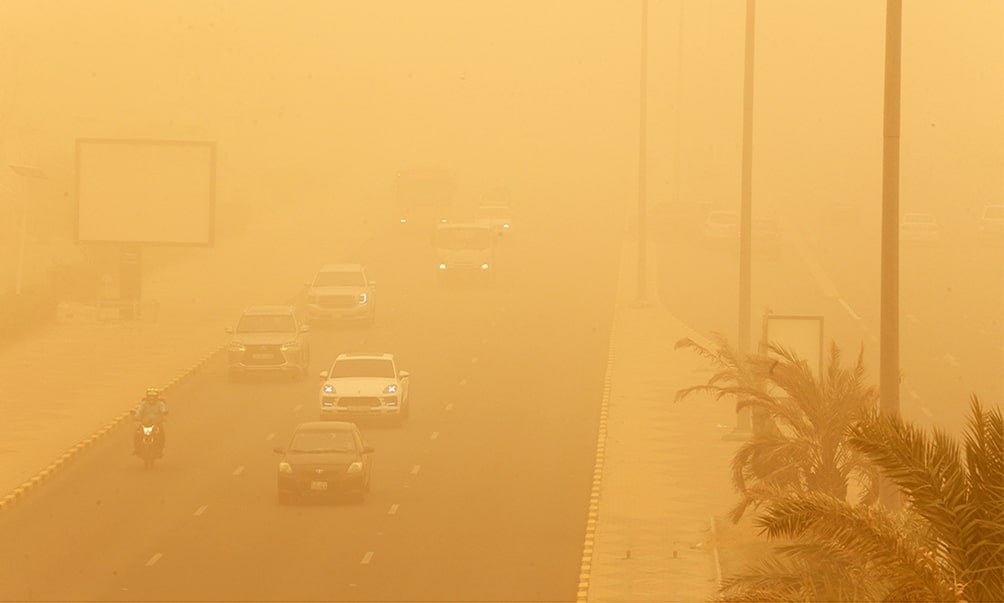KUWAIT: Flights to and from Kuwait International Airport were temporarily halted on Monday due to a dust storm that reduced visibility throughout Kuwait. Flights have been affected with the current weather conditions, said Imad Al-Jalawi, Deputy Director General for Air Navigation Services at the Directorate General of Civil Aviation. The flight schedule will be reviewed and regular flights will resume once visibility improves, Jalawi added. He added that Kuwait is currently affected with low visibility conditions along with strong winds reaching more than 50 km/h.
Meteorologist Jamal Ibrahim said the sandstorm that engulfed Kuwait will cover most of the country. Ibrahim said conditions could start improving by Tuesday evening, while temperatures could reach 43 degrees Celsius. Meanwhile, another sandstorm that descended Monday on Iraq sent at least 2,000 people to hospital with breathing problems and led to the closure of airports, schools and public offices across the country. It is the eighth dust storm since mid-April to hit Iraq, which has been battered by soil degradation, intense droughts and low rainfall linked to climate change.
The last one earlier this month led to the death of one person while 5,000 others had to be hospitalized for respiratory problems. On Monday a thick cloud of dust enveloped the capital Baghdad in an orange glow and blanketed many other cities including the Shiite shrine city of Najaf to the south, and Sulaimaniyah, in the northern Kurdish autonomous region, AFP correspondents said.
Yellow and orange sand covered building roofs, cars and even crept into homes. Authorities in seven of Iraq’s 18 provinces, including Baghdad, ordered government offices to shut. But health facilities remained open to assist those most at risk, including the elderly and people suffering from chronic respiratory diseases and heart ailments.
By midday at least 2,000 people were admitted to hospitals across Iraq in need of oxygen, said health ministry spokesman Seif Al-Badr. AFP correspondents saw around 20 patients, most of them elderly men, at Baghdad’s Sheikh Zayed Hospital. One of them was Hadi Saada, 70, lying on his side on a bed in the intensive care unit hooked to a respirator. He struggled to breathe. “It is his third time in hospital” since the sandstorms began in April, said his son Mohammed Saada, adding that his father had a heart condition.
Another patient, Khaled Jassem, 70, was also hooked to an oxygen tank. “We’ve been here since 8:00 am... My father has a heart ailment, diabetes, hypertension and is suffocating on the dust,” said his son Walid Jassem. At least 75 people struggling to breathe were admitted Monday to Sheikh Zayed, said Talib Abdelmoneim Nejm, one of the ICU officials.
The sandstorm drastically reduced visibility to just 300 m at Baghdad airport, prompting authorities to close airspace and halt flights, state-run INA news agency reported. Airports in Najaf and Sulaimaniyah were also closed for the day, the agency said. Schools nationwide were also shuttered and end of year exams postponed to Tuesday. Universities also delayed exams. The latest sandstorm was expected to gradually dissipate by Monday evening, weather services said.
The Middle East has always been battered by dust and sandstorms but they have become more frequent and intense in recent years. The trend has been associated with overuse of river water, more dams, overgrazing and deforestation. Iraq is rich in oil and is known in Arabic as the land of the two rivers - in reference to the legendary Tigris and Euphrates rivers.
But the supply of water has been declining for years and Iraq is classified as one of the world’s five countries most vulnerable to climate change and desertification. In April, an environment ministry official warned that Iraq could face “272 days of dust” a year over the next two decades. - Agencies











